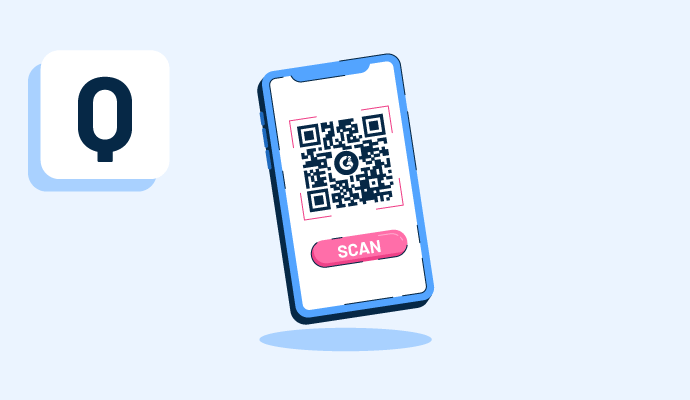What is a QR code?
Quick response (QR) codes are barcodes that can be scanned with smartphone cameras. They store data that users can interact with, such as links to web pages or files like photos or videos.
With QR code generator software, new codes can be created to be used online and in physical materials. For instance, QR codes can be printed on posters or flyers for users to scan and access the information connected to them.
Although similar to traditional barcodes, QR codes can hold much more data – up to 406 bytes per code. Their design allows for easy scanning on devices that most people now have in their pockets, making the information they link to more accessible to a broader audience.
Types of QR codes
The designs of most QR codes look very similar, and to a user, the type of code being used isn’t distinguishable. For a code creator, though, it’s essential to understand the differences between the two main types of code:
- Static QR codes. These codes link to information that can’t be changed once the link is live. This also means that data around the code’s usage cannot be tracked, and any new information will need an updated QR code.
- Dynamic QR codes. With these codes, information can be updated at any time, and user data can be tracked throughout the lifetime of the QR code. Real-time monitoring is often possible with these codes, making them particularly useful for sales and marketing teams.
Basic elements of QR codes
Most QR codes are square-shaped grids containing unique binary codes made up of six core components:
- Quiet zone. This is the white border around the code that tells QR code readers where the code ends.
- Finder pattern. Every code has three black squares in the left and top right corners to align the code within a reader. These are the boundary markers between the quiet zone and the code pattern.
- Timing pattern. Within the finder pattern is an L-shaped line, which allows even a damaged QR code to be read.
- Alignment pattern. Like the timing pattern, this small square in the bottom right corner makes it possible for the code to be read when blurry or tilted at an angle.
- Version information. This is a small section of the code in the top right finder pattern that tells the QR code reader what type of code it is.
- Data cells. This is all the remaining code information, such as the web link, phone number, or other data.
Benefits of QR codes
As QR codes can be used for many different purposes, the benefits that they come with are numerous. Some of the most important ones are:
- They enable businesses to market to customers anywhere. Marketing teams frequently use QR codes on signage and print advertising to drive prospective customers to additional details about a business. From newsletter signups to shopping on a mobile device, QR codes make it possible for businesses to reach new people anywhere.
- They’re free to use and easy to set up. A QR code generator is an accessible and inexpensive way to share information. Anyone can quickly create a code and share it.
- They support touchless access to business information. Being able to view information without physical materials meant that QR codes saw a resurgence due to the COVID-19 pandemic. Restaurants and bars, in particular, made the switch from physical menus to QR codes on every table, allowing customers to view information on their own devices at any time.
Best practices for using QR codes
Whether a business is using a QR code for the first time or has been using them frequently, following these best practices keeps users engaged and interested in what’s being shared.
- Personalize codes to catch users’ attention. With many companies now using QR codes, creating one that matches the business’s color palette keeps branding consistent across all marketing materials.
- Make sure the code is readable by scanners. A QR code that can’t be scanned is useless. All codes should be at least 0.8 inches x 0.8 inches in size, with a 10:1 distance ratio. There should also be a high contrast between the code and background color to make scanning easier.
- Don’t overcrowd a code in print or online. Just as clarity and sharpness in a code is essential, so is keeping space around the code clear. Scanners may find it difficult to distinguish the borders of QR codes if other text or images are placed too close.
- Denote where the QR code will take a user. Cybersecurity is something that everyone should be concerned about. Knowing exactly where a user will be going when they scan a QR code is essential for keeping their data safe. The URL also acts as a backup should the QR code not work or if someone doesn’t have the correct device to use the code.
Promote your business and track QR code usage in real time with digital analytics software.

Holly Landis
Holly Landis is a freelance writer for G2. She also specializes in being a digital marketing consultant, focusing in on-page SEO, copy, and content writing. She works with SMEs and creative businesses that want to be more intentional with their digital strategies and grow organically on channels they own. As a Brit now living in the USA, you'll usually find her drinking copious amounts of tea in her cherished Anne Boleyn mug while watching endless reruns of Parks and Rec.





















